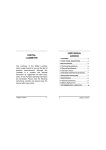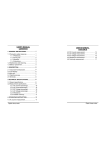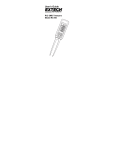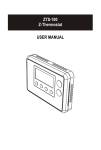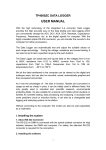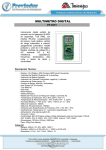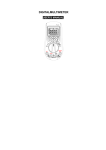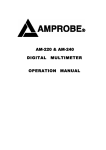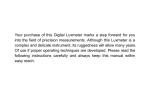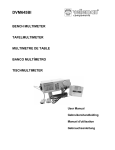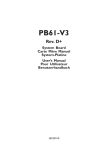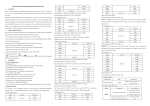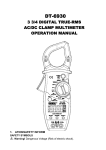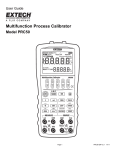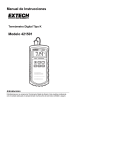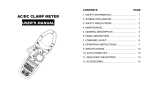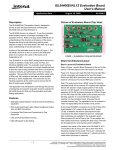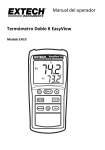Download Pen R/C Meter for SMD Model AX-503
Transcript
Pen R/C Meter for SMD Model AX-503 INSTRUCTION MANUAL 1. GENERAL INSTRUCTIONS This pen R/C meter for SMD could fast precise measure small chip components. To get the best service from this meter, please read this user's manual carefully and observe the detailed safety precautions strictly. 1.1. Precautions safety measures * When using this meter, the user must observe all normal safety rules concerning 1.1.1. During use * Use the meter before must warm-up 30 seconds. * If the meter is used near noise generating equipment, be aware that display may become unstable or indicate large errors. * Do not use the meter if it looks damaged. * Use the meter only as specified in this manual; otherwise, the protection provided by the meter may be impaired. * Do not operate the meter around explosive gas, vapor, or dust. * To avoid damages to the instrument, do not exceed the maximum limits of the input values. * Caution : Avoid working with voltages above 50VDC or 36VAC rms. Such voltages pose a shock hazard and can damage the meter. * When using this meter, keep your fingers away from the metal of the meter. * Before changing functions, disconnect the test clip from the circuit under test. * Replace the battery when the false display . symbol appears. With a low battery, the meter might produce 1.1.2 Symbols: Symbols used in this manual and on the meter: Caution: refer to the instruction manual. Incorrect use may result in damage to the device or its components. Conforms to IEC1010 2 1.1.3. Instructions * Before operating the meter, always disconnect from all sources of electric current and make sure you are not charged with static electricity which may destroy internal components. * Any adjustment, maintenance or repair work carried out on the meter while it is live should be carried out only by appropriately qualified personnel, after having taken into account the instructions in this present manual. * If any faults or abnormalities are observed, take the instrument out of service and ensure that it cannot be used until it has been checked out. * If the meter is not going to be used for a long time, take out the battery and do not store the meter in high temperature or high humidity environment. * Never use the meter unless the back cover and battery cover are in place and fastened fully. 2. DESCRIPTION 2.1. Instrument Familiarization 3 1 5 4 6 2 1. 2. 3. 4. 5. 6. cathode anode ”REL” key ”FUNC.” key LCD display Battery cover 2.2. LCD Display 2.3. FUNC. key----Function key This key is used to select the functions of the meter. Press this key once, the meter will turn on ad. Then press and hold this key for over 4 seconds, the meter will power off. 3 2.4. REL key----Relative measurement key This key is used to select the Relative measurement mode. Press this key once to enter into the Relative measurement mode, then press this key again, it will back to the normal mode. 2.5. Terminals ∞ + :Terminal receiving the anode ∞ - :Terminal receiving the cathode Only for measuring the diode and the polar capacitance 3. TECHNICAL SPECIFICATIONS 3.1. General specifications ∞ Environment conditions Pollution degree: 2 Altitude: < 2000 m Operating temperature: 0~40 OC, (<80% RH, non-condensing) Storage temperature: -10~60 OC, (<70% RH, battery removed) ∞ Temperature Coefficient:0.1×(specified accuracy) / OC (<18 OC or >28 OC) ∞ MAX. voltage between terminals and earth ground: 50V DC or 36V AC rms 。 ∞ Sample Rate: 3 times/sec for digital data ∞ Display: 3 3/4 digits LCD display with max. reading 3999 ∞ Over Range indication: LCD will display "OL" ∞ Low battery indication: The " " is displayed when the battery is under the proper operation range ∞ Auto power off If there is no key been operated for 15 minutes, the meter will auto power off to save battery energy. ∞ Power source: 3.0V battery ∞ Dimensions: 181(L)×35(W)×20(H) mm ∞ Weight: 65g. approx. (battery included) 4 3.2 Measurement specifications * Accuracy: ±(% of reading + number of digits) at 18OC to 28OC (64OF to 82OF) with relative humidity to 80%. Caution when working with voltages above 50Vdc or 36Vac rms. 3.2.1 Resistance Range Resolution 400Ω 0.1Ω 4kΩ 1Ω 40kΩ 10Ω 400kΩ 100Ω 4MΩ 1kΩ 40MΩ 10kΩ Accuracy ±(1.2% of rdg +3digits) ±(2.0% of rdg +5 digits) 3.2.2 Capacitance Range Resolution Accuracy 4nF 1pF ±(5.0% of rdg +5 digits) 40nF 10pF 400nF 100pF 4µF 1nF 40µF 10nF 200µF 100nF ±(3.0% of rdg +5 digits) ±(3.0% of rdg +5 digits) Keep two pins of the capacitance in short before measuring 5 3.2.3 Diode Test Range description Display read approx. forward voltage of diode Test Condition Forward DC Current: approx. 1mA Reversed DC Voltage: approx. 1.5V 4. OPERATING INSTRUCTION 4.1. Resistance measurement To avoid electrical shock or damages to the meter under test, disconnect circuit power and discharge all high-voltage capacitors before measuring resistance. ∞ Select the function at mode. ∞Connect the test clip to the object being measured and the measured value will show on the display. NOTE: ∞ For measuring the high-resistance above 1MΩ, it may take a few seconds to stabilize the reading. This is normal for high resistance measuring. ∞ When the input is not connected, i.e. at open circuit, the figure "OL" will be displayed for the overrange condition. 4.2. Capacitance measurement To avoid electrical shock or damages to the meter under test, disconnect circuit power and discharge all high-voltage capacitors before measuring capacitance. Keep two pins of the capacitance in short before measuring. ∞ Select the function at mode. ∞ Connect the test clip to the capacitor being measured and read the displayed value. NOTE: ∞ The meter may take a few seconds (200µF range, 30 seconds) to stabilize reading. This is normal for high capacitance measuring. ∞ To improve the accuracy of measurements less than 4nF, subtract the residual capacitance of the meter and clip. (Press the REL key to enter into the Relative measurement mode when it is in the open circuit state) 6 4.3. Diode measurement To avoid electrical shock or damages to the meter under test, disconnect circuit power and discharge all high-voltage capacitors before testing diodes. ∞ Select the function at mode. ∞ Connect the + pin to the anode, the - pin to the cathode of the diode under testing. ∞ The meter will show the approx. forward voltage of the diode. If the lead connection is reversed, only figure "OL" displayed. 5. MAINTENANCE 5.1. General Maintenance Periodically wipe the case with a damp cloth and mild detergent. Do not use abrasives or solvents. 5.2. Battery replacement Before replacing the battery, disconnect test leads from any circuit under test, turn the meter off and remove test leads from the input terminals. Use the following procedure: When the battery voltage drops below proper operation range the LCD display and the battery needs to be replaced. symbol will appear on the ∞ Press the battery cover and towards arrowhead direction to open the battery cover. ∞ Replace the battery with two new 1.5V batteries(AG13). ∞ Replace the battery cover. 7







